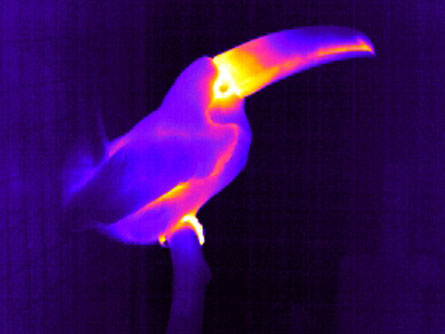Toco toucans have a huge cooling bill. But it’s the good kind.
While overheated people crank up their air conditioning, toucans increase the blood flow to their supersized, uninsulated bills, report Glenn Tattersall of Brock University in St. Catharines, Canada, and his colleagues. Extra heat radiating from the bill keeps the bird comfortable.
When the bird no longer needs a big chill, blood flow slows, the researchers say. They present, in the July 24 Science, thermal imaging of bills changing temperature.
This new study adds an “entirely plausible” twist to a long-standing subject of debate, says morphologist Winston Lancaster of California State University in Sacramento. “I suspect that few people have ever seen a toucan without wondering, ‘Why the beak?’”
But documenting cooling powers for the toucan bill doesn’t mean other ideas for its function are wrong, says coauthor Denis Andrade of the São Paulo State University’s campus in Rio Claro, Brazil. The beaks of toucans work well for picking tropical fruits, for example. “The bill has many functions,” he says.

Aside from addressing a curiosity, the work also stirs up new questions about bird beaks as evolutionary adaptations to the environment, Lancaster says. Birds and other animals that generate their own warmth sometimes face a critical need to lose heat. Yet birds pick apart their food with their beaks. Developing the perfect heat-radiating bill might lead to structures awkward for food handling. “Adaptation is always a trade-off,” he says.
To test the cooling properties of bills, the researchers focused on the toucans with the largest bill, the toco toucan (Ramphastos toco). The bill of an adult bird can account for up to half of its body surface area. Under the hard, hornlike outer covering of the bill lies a network of blood vessels.
Researchers put birds one at a time into a temperature-controlled chamber. Over the course of six hours, the chamber warmed 10 degrees Celsius. Thermal imaging similar to the type that lets airlines check passengers for fevers showed the researchers how various parts of the birds’ bodies changed temperatures during the warm-up.
As the temperature increased, the birds’ bills warmed too, a change that the researchers interpret as a sign that the bird was flooding its beak vessels with extra blood. Yet the unfeathered skin around the birds’ eyes, an indicator of core body temperature, stayed about the same.
Toucans also spent a night in the chamber as researchers monitored bill temperature during sleep. When the birds settled down, their bills warmed up, suggesting they were dumping heat. Animals typically cool down as they fall asleep. Later in the night, heat occasionally flared from the bill. Perhaps changes in sleep states affect body temperature regulation, the researchers speculate.
When researchers chased toucans around the aviary for 10 minutes, the birds’ bills also showed a burst of heat radiation. “The question now is how widespread this is among birds,” says Brian McNab of the University of Florida in Gainesville. Hornbills also live in the tropics and wield impressive bills, so McNab wonders if they too thermoregulate through bill cooling. Hornbills aren’t closely related to toucans, so a similar bill function might uncover a new example of convergent evolution.
Earlier research on ducks did show a small percentage of heat loss through the bill when the bird was at rest, Tattersall says. As for information on other birds, “Stay tuned,” he says.





